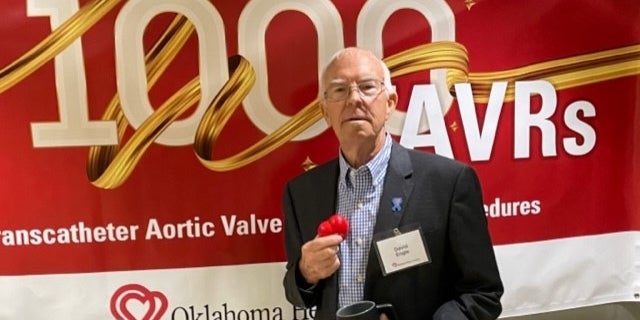Physical therapy after open-heart surgery was tough on David Engle. Recovering from a triple bypass and a heart valve replacement was not easy on his body or mind. When his cardiologists told him he would need another open-heart surgery for a valve replacement seven years later, Engle refused.
“I said, ‘No, we’re not going in.’” said Engle. “Recovery and physical therapy was too hard on me.”
Luckily, there was an alternative. Engle’s cardiologist in Arkansas told him about Kamran Muhammad, M.D., the director of the Structural Heart Disease Program at Oklahoma Heart Institute (OHI). He performed the first transcatheter aortic valve replacement (TAVR) in Tulsa and the area. This minimally invasive approach reduces the risk of surgical complications and allows patients to recover more quickly and go home sooner than traditional surgeries. Engle could also avoid the difficult physical therapy he feared.
“Open-heart surgery is a very invasive operation, so there’s a lot of pain and discomfort and shortness of breath.” said Dr. Muhammad. “It’s a long recovery, painful recovery. Most people take about a year to feel back to normal. Just the trauma, the stress of the surgery, it takes about a year to feel better.”
“Dr. Muhammad is one of the kindest and most empathetic men that I have ever met. He explained everything that he could do for us. He’s just got a gentleness that says, ‘You’re gonna be okay. Just trust me.’ I trusted him,” Engle said. “Before we left the first consultation, he put his hand on my knee and said, ‘David, we’re all brothers. We can fix this.’ That’s what OHI offers all of us that need this procedure. Hope.”
Engle had his TAVR procedure in 2018. OHI and Dr. Muhammad receive many referrals from out-of-state patients near to northeast Oklahoma, so they can stay close to home or at home as they recover.
“Patients don’t have to go to Chicago and Dallas, they can just come to Tulsa,” said Dr. Muhammad. “Because not only do we do all the FDA-approved things like TAVR, but we’ve been doing them for a decade.”
After his successful procedure, Engle had an adverse reaction to his anesthesia; he panicked, believing he was paralyzed. Dr. Muhammad was called in to help calm him down.
“I woke up almost psychotic,” Engle said. “They had to call Dr. Muhammad and he came over to the hospital. He put both his hands on my arm, and he said, ‘You’re going to be alright.’ I’ll never forget that.”
Engle says throughout his entire experience at OHI, Dr. Muhammad and his staff gave him hope. He now refers to OHI as the “Oklahoma Hope Institute.”
“It’s the attention that’s paid to the patient. It’s phenomenal,” said Engle. “And I just don’t think you get that anywhere. But that’s what Oklahoma Hope Institute does.”
Now, after 11 procedures and 14 stents, Engle’s heart is healthy.
“Everybody says the same thing,” Engle laughed. “‘Your heart sounds amazing. You sound like a 40-year-old in an 80-year-old body.’”
Engle says the staff at OHI repeatedly made him feel like the only patient in the hospital with their careful attention and encouragement.
“All they cared about was that I get up and walk, and make it happen so I could go home. That’s all they wanted me to do, was to go home.” said Engle.
In November 2022, OHI celebrated its 1,000th TAVR procedure, completed by Dr. Muhammad. Engle attended OHI’s celebration and spoke about his experience. He says OHI has given him the opportunity to spend the holidays with his family, including 16 grandchildren and one great-grandchild.
“The reason I’m still here is because somebody put a little valve in my valve that didn’t work,” Engle said. “I still don’t understand it, but all I know is it works.”
“Medicine is always advancing; we’re always doing research. Why? Because we want to help patients,” said Dr. Muhammad. “We don’t want them to only have one or two options, we want them to have many options.”
To learn more about TAVR and the other treatments OHI offers, click here.

